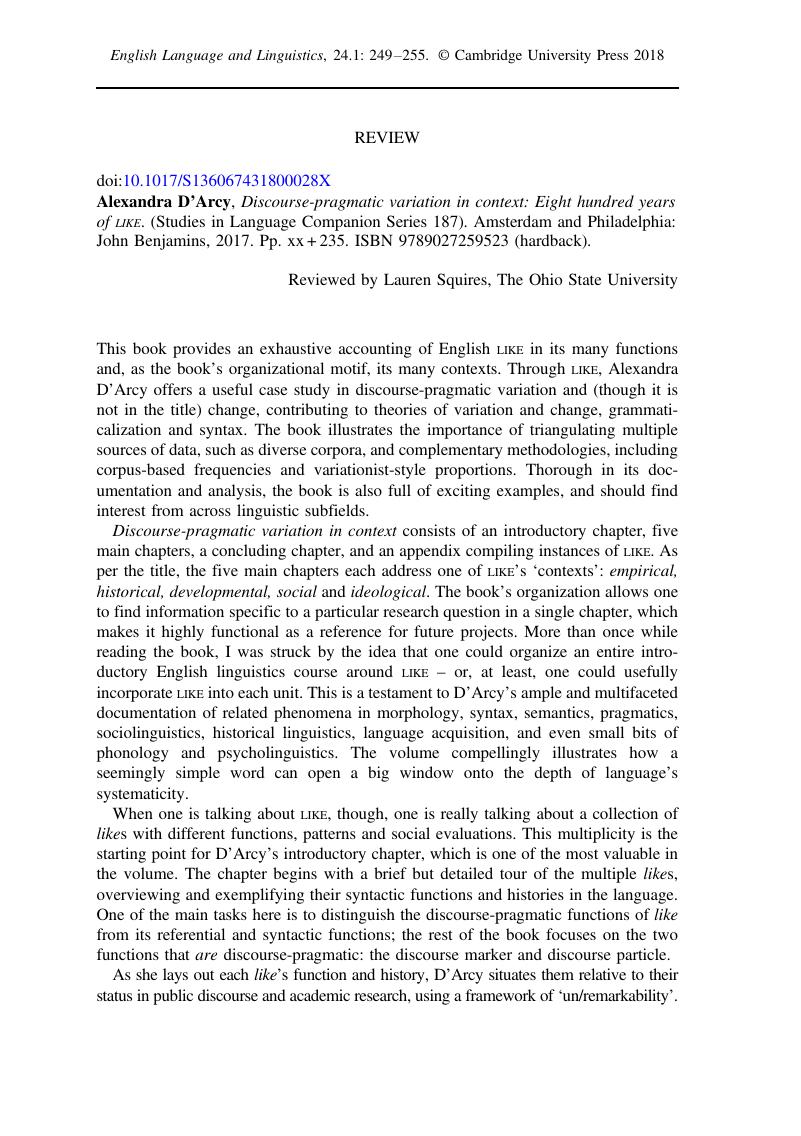No CrossRef data available.
Article contents
Alexandra D’Arcy, Discourse-pragmatic variation in context: Eight hundred years of like. (Studies in Language Companion Series 187). Amsterdam and Philadelphia: John Benjamins, 2017. Pp. xx+235. ISBN 9789027259523 (hardback).
Published online by Cambridge University Press: 06 November 2018
Abstract
An abstract is not available for this content so a preview has been provided. Please use the Get access link above for information on how to access this content.

- Type
- Book Review
- Information
- Copyright
- Copyright © Cambridge University Press 2018
References
Aijmer, Karin & Lewis, Diana (eds.). 2017. Contrastive analysis of discourse-pragmatic aspects of linguistic genres. New York: Springer International Publishing.Google Scholar
Johnstone, Barbara & Kiesling, Scott F.. 2008. Indexicality and experience: Exploring the meanings of /aw/‐monophthongization in Pittsburgh. Journal of Sociolinguistics 12(1), 5–33.CrossRefGoogle Scholar
Labov, William. 1972. Sociolinguistic patterns. Philadelphia, PA: University of Philadelphia Press.Google Scholar
Labov, William. 1990. The intersection of sex and social class in the course of linguistic change. Language Variation and Change 2(2), 205–254.CrossRefGoogle Scholar
Lavandera, Beatriz R. 1978. Where does the sociolinguistic variable stop? Language in Society 7(2), 171–183.CrossRefGoogle Scholar
Lewis, Mark C. 2018. A critique of the principle of error correction as a theory of social change. Language in Society 47(3), 325–346.CrossRefGoogle Scholar
Pichler, Heike (ed.). 2016. Discourse-pragmatic variation and change in English: New methods and insights. Cambridge: Cambridge University Press.CrossRefGoogle Scholar
Preston, Dennis R. 1996. Whaddayaknow? The modes of folk linguistic awareness. Language Awareness 5(1), 40–74.CrossRefGoogle Scholar
Rickford, John R. 2018. Crafting a more integrated, specific, and community-sensitive approach to applied sociolinguistics. Language in Society 47(3), 364–368.CrossRefGoogle Scholar
Romaine, Suzanne & Lange, Deborah. 1991. The use of ‘like’ as a marker of reported speech and thought: A case of grammaticalization in progress. American Speech 66(3), 227–279.CrossRefGoogle Scholar
Silverstein, Michael. 1979. Language structure and linguistic ideology. In Paul R. Clyne, William F. Hanks & Carol L. Hofbauer (eds.), The elements: A parasession on linguistic units and levels, 193–247. Chicago: Chicago Linguistic Society.Google Scholar
Silverstein, Michael. 1981. The limits of awareness. Sociolinguistics Working Paper no. 84. Austin, TX: Southwest Educational Development Laboratory.Google Scholar




